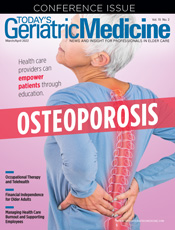
March/April 2022
The Last Word: Palliative Care It’s not a prognostically driven specialty. Twelve years ago, I was asked to see a 21-year old man in the hospital. He’d been diagnosed with Burkitt lymphoma, a cancer typically found in young men and considered curable. This young man found the treatments intolerable, particularly the nausea and vomiting, and was unwilling to continue with any further tumor-directed therapies. He believed he was ready to develop an end-of-life plan. I applauded the oncologist for bringing me into his care team. However, like too many clinicians today, his doctor had a misconception about the work palliative care specialists do. We are not just trained to help people die. We are specialists in the management of complex symptoms and side effects—physical, emotional, social, and spiritual—that make chronic and terminal illnesses difficult to bear. We have a toolbox of interventions, of which many (if not most) other clinicians simply aren’t aware. I wasn’t ready to let this young man die. I suggested we start by treating his nausea. While he and his other doctors thought they had already tried everything, he was willing to give my recommendation—part of a palliative physician’s bag of symptomatic tricks—a try. He began my treatment that day. The next day, we had a meeting together over chicken nuggets and a Coca-Cola. He continued with my treatments, finished his chemotherapy, and, to the best of my knowledge, his cancer is still in remission. How to Integrate Palliative Care With Advanced Disease Management Research has demonstrated that, at least in the advanced lung cancer population, if you offer a palliative consultation early after diagnosis, patients have a better quality of life with a lower symptom burden, 50% less depression, and even live longer than those who receive standard oncology care.1 So, how do we help clinicians recognize the specialized capacity palliative medicine specialists have outside the palliative and hospice environment? Education is imperative. We need to remind everyone in the medical field continuously, through conversation and other communications, that palliative medicine doctors aren’t limited to treating patients with terminal prognoses. We don’t accelerate a terminal process. Palliative care is not a service reserved for the end of life. Rather, we need to advance an awareness that we help alleviate suffering for patients and their families regardless of where they are in their illness journeys. We help the primary treating physicians with quality of life issues their patients face, freeing clinicians to focus on managing the treatment protocols. We also help the health care system save money by bringing palliative resources to the table, increasing length of stay in hospice and decreasing acute care utilization. In an era when value-based care is becoming more prominent, reducing costs while improving patients’ quality of life benefits everyone. Networking plays an important role in advancing palliative medicine. Palliative specialists need to reach out to our colleagues (oncologists, nephrologists, cardiologists, gerontologists, and even primary care physicians) to share our success stories and help them understand that the work we do supports their work. Whether delivered inside or outside the hospice environment, our mission is to alleviate suffering. Every doctor should want that for their patients. Patients and their families can also promote the specialty by telling their primary care clinicians and friends how it has helped them cope with their illnesses. By sharing their own stories, they can increase demand for the kind of holistic care palliative medicine provides. As we move into a future where palliative medicine is widely recognized as a specialty that improves outcomes and allows people to live better for longer, it should be adopted as a paradigm of care that is integral to advanced disease management. To ease the transition, clinicians and health systems now have access to analytical resources that help identify patients within their community who could benefit from palliative resources. Using technology that provides an objective analysis based on a patient’s full medical, social, and emotional profile, clinicians can ensure that each of their patients with a serious illness has the opportunity to get the right care, at the right time, in the right setting. As a pragmatic optimist, I hope that my specialty becomes routine, ordinary, and expected. In fact, I hope someday it will be malpractice not to offer patients something we know has a unique ability to heal. — John Mulder, MD, is chief medical consultant for hospice and palliative care at Holland Home, the largest provider of elder care services in Michigan. He’s director of palliative medicine for the Michigan State University College of Human Medicine, medical director for palliative care at Metro Health, University of Michigan Health, and program director for Mercy Health Grand Rapids palliative medicine fellowship program. He is also a member of the board of directors for the data analytics firm Acclivity Health.
Reference |
